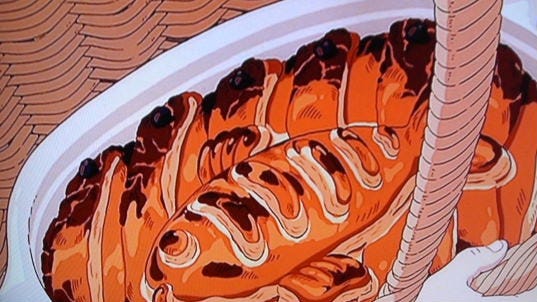#44: Kiki's Delivery Service and the Herring Pot Pie
Studio Ghibli's home delivery heroine and why anime food looks so good right now—even the herring.
“Flying used to be fun until I started doing it for a living,” says Kiki, a young 13-year-old witch, during a particularly prescient moment of Hayao Miyazaki’s Kiki’s Delivery Service (1989). Kiki has just lost her witch’s powers, her “spirit,” and is desperate to find it again. Like all young witches in this world, she had left home to find her very own special skill. Her flying delivery service is something landed-on more by chance than by choice, as she makes deliveries on her mother’s hand-me-down broom of everything from birthday gifts and bread to rejected baby pacifiers.
The delivery service is successful, largely because Kiki’s disposition and work ethic make it so. Optimistic, ambitious, a dreamer, and a giver, she has big Anne of Green Gables energy (There’s even a moment that she gazes longingly through a store window at some shiny red shoes, not unlike Anne’s dreams of a puff sleeve dress). But Kiki’s feelings of being an outsider, a witch in a town of not-witches, weigh on her spirit. Before these feelings really take hold and render her unable to fly, Kiki makes a delivery pick-up that brings her inside the home and kitchen of an elegant old woman and her kindly caretaker Barsa who are fussing over an unbaked herring pot pie. They had planned to have it prepared it in time to be delivered for her granddaughter’s birthday until the electric oven went kaput. Kiki, in her way, offers to tend the old wood-fired oven, and soon the pie is golden and fizzling.
Nothing makes this movie a product of the 80’s so much as its creamy white casserole dish, pastel-painted and hefty. Within it, a thick buttery crust is decorated with a flaky fish cut-out, details down to the eye ball and gills, striped with crust on the diagonal, and dotted along the edge with jet black olives. Contrasts of golden yellow to orange to brown crispy bits are so vividly captured, the steam so ribbony and thick, that you forget there’s herring inside it.
Can you crave herring if you’ve never had it, anyway? I’ve watched Kiki’s Delivery Service twice in the past month: the first time utterly confounded by how delicious it makes herring look and the second to confirm or deny whether I actually want to make this recipe or just keep daydreaming about it. I still haven’t decided. I have, however, learned a lot about herring. A bait fish, they travel in schools, glittering and metallic. Like their sardine siblings, the bones are also small enough to eat. It also turns out that US commercial fishing makes it particularly difficult to sustain the herring market for anything other than roe, which is most profitable. It’s at this time that I will bravely share a link to a TEDx talk from a man in a jaunty hat about how it’s better to eat smaller fish. I’m certainly convinced, but I also conveniently enjoy tinned fish. The bottom line is: herring meat is a blank slate that’s perfect for smoking, salting, crisping up with lots of oil or tossing into an anime casserole.
The community around anime food is so vast that recreations of Studio Ghibli food have taken up literal residence in this town in Taiwan, and you can get your very own art print of virtually any Ghibli dish thanks to this delightful Etsy shop. If you’re eager to recreate something yourself, https://animerecipes.tumblr.com/ is a quick hit for such endeavors and might even point you to your next favorite movie at the very least.
I’ve only recently dipped my toes into anime television, and even in shorter, episodic form, food scenes are the visual, sensory hook for me. But the herring pot pie in Kiki’s Delivery Service is so disarming in its rich colors, decoration, delicate lines and crackling sounds, that it’s hard to conceive of anything that could possibly be more delicious. I’d venture to say that it’s the best dish on planet Ghibli, which makes it all the more upsetting when Kiki makes the delivery in the pouring rain and the receiving granddaughter calls it “crummy.” Rude.
Hayao Miyazaki’s food creations are so beautifully wrought, so tender even at the bizarrest of plot points, that it becomes impossible to extricate the food from the message, the message from the food. It could very well be the design that elevates such a fishy thing, but it’s also the circumstance of food and process as gift: the grandmother’s to the granddaughter, and then, when old age and appliances stand in the way, the time and effort of a young delivery girl who sees a way forward in less than ideal circumstances. As we near the end of 2020, I am still leaning on delivery and pick-up services more than I ever have, and when I can’t see as much of the world around me as I’d like, Kiki’s world is transportive as she grapples with the real, persistent struggle of burnout and recovery of spirit.






